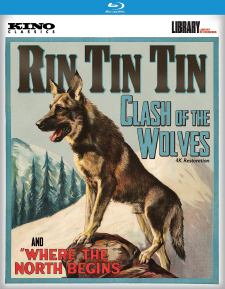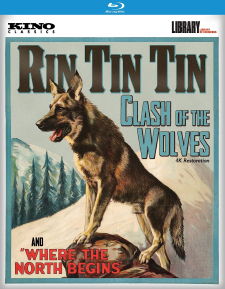Clash of the Wolves/Where the North Begins (Blu-ray Review)

Director
Noel M. Smith/Chester M. FranklinRelease Date(s)
1925/1923 (June 20, 2023)Studio(s)
Warner Bros (Kino Classics)- Film/Program Grade: See Below
- Video Grade: C
- Audio Grade: A
- Extras Grade: C
Review
Rin-Tin-Tin was a German shepherd rescued from a World War I battlefield by an American soldier, Lee Duncan, who trained and secured work for him in silent movies. The dog appealed to audiences and his films were so successful that he was cast as a pivotal character in several feature films. Two of them, Clash of the Wolves and Where the North Begins are double-billed in a new Blu-ray release.
In Clash of the Wolves, a forest fire in the mountains drives a wolf pack into the desert, where they prey on cattle and terrorize local residents. The leader of the pack is Lobo (Rin-Tin-Tin), a dog/wolf halfbreed. When the wolves are discovered hunting a steer, a posse tries to shoot them. To protect the pack, Lobo lures the pursuers to chase him instead, and is badly injured in a fall from a cliff into a cactus. A kindly young prospector, Dave Weston (Charles Farrell, 7th Heaven), happens upon the half-dead animal and manages to get it back to his cabin to relieve its suffering. Weston removes the cactus needles, applies antiseptic, and nurses the canine back to health. The dog instincts of the wolf-dog kick in and he and his savior bond.
Weston has discovered borax in the area. His girlfriend, May Barstow (June Marlowe), daughter of a wealthy rancher, is pleased. But the local chemist at the assay office, “Borax” Horton (Pat Hartigan), also has eyes on May and on Weston’s rich claim. He decides to get rid of Weston, jump his claim, and win May in the bargain.
Lobo also has a mate. Nanette is back at the den, caring for their pups and waiting for Lobo to return. Lobo eventually is torn between his attachment to Weston and his natural instincts.
If this were a traditional drama, it wouldn’t be special. What distinguishes it is the canine star of the film. Performing complex stunts integral to the plot and endearing himself to us with his expressive face, he’s truly astonishing. Rin-Tin-Tin was the first dog star—pre-dating Lassie by two decades—so such canine exploits had never before been seen by a mass audience. Whether jumping onto bad guys from a high rock, racing away from a posse through treacherous terrain, rolling down a hill, filling a canteen with water from a stream, trying to extricate cactus needles from his paw, crawling when he’s unable to walk, tapping at a window, or jumping over a gap from one mesa to another, he’s a truly extraordinary performer.
The human stars, by comparison, are there to move the narrative along, so Rin-Tin-Tin dominates. The photography takes advantage of the picturesque locations, and some compositions are reminiscent of Ansel Adams photographs. The dog has the uncanny ability to elicit empathy from the viewer with a look that suggests he knows what’s going on. We understand exactly what he’s thinking, thanks to his exceptional performance and helpful editing. One visual gag that doesn’t work is a beard placed on Lobo as a disguise. It looks dopey and couldn’t fool a fool. The bit that does work is how skittishly horses behave when Lobo is near, since—beard or no beard—they know he’s part wolf.
In the second film, Where the North Begins, a German shepherd puppy in a crate falls off a sled and is adopted by a pack of wolves in the frozen Great North. A few years later in a fur-trading settlement, we meet Felice McTavish (Claire Adams) and her boyfriend, trapper Gabrielle Dupree (Walter McGrail). Shady settlement boss Shad Galloway (Pat Hartigan) also has his eyes on Felice. He offers Gabrielle the rich sum of $500 to bring furs through the dangerous Caribou Pass. Gabrielle tells Felice they can marry and start a comfortable life together with that money, but Galloway has other plans. He orders his servant known as The Fox (Charles Stevens) to ambush Gabrielle in the wilderness.
The Fox obeys and leaves Gabrielle for dead, but the hardy trapper is unconscious. Badly wounded and likely to freeze to death in the snow, Gabrielle is instead discovered by the dog taken in years earlier by the wolves. The dog manages to get Gabrielle to a cabin, where he recovers, the two bond, and the dog accompanies the man as he heads home. Learning that Gabrielle is still alive, Galloway orders The Fox to finish the job. Only now, the hunter has a fearsome protector by his side.
Not as satisfying as Clash of the Wolves, Where the North Begins is pure melodrama. The dog is largely absent from the screen for far too long and the stunts are not at all as impressive as in the first film. Driven more by sentiment than by a gripping script, the picture spends too much time with its human actors and not enough with its canine star. A chase at the end perks things up, but there are too many dull stretches. At a mere 73 minutes, the film seems longer.
Clash of the Wolves (Film Grade: A) / Where the North Begins (Film Grade: C)
Clash of the Wolves was shot by directors of photography Edwin B. DuPar and Allen Q. Thompson and restored in 4K. Several black scratches run nearly the entire length of the film. They are most prominent during the opening credit sequence. The cinematography is excellent, and some images are majestic, such as a long shot of fire engulfing an entire forest. Rin-Tin-Tin does some amazing stunts, but for the safety of the animal, a key scene in which he jumps from one mesa to another over a deep chasm is accomplished with a special-effect glass shot. Rin-Tin-Tin is often filmed on a hill, looking regal as he surveys his domain. Even a dog can get the glamour treatment. Editing is critical in creating drama, and the camera is sped up in chases to make them look more exciting. Clash of the Wolves was inducted into the National Film Registry in 2004.
Where the North Begins was scanned in 2K as part of the Library of Congress’s Silent Film Project. There’s no director of photography listed, but F.N. Murphy is credited for “Electrical Effects” for both this film and Clash of the Wolves. Both films were shot with spherical lenses on 35 mm black-and-white film and presented in the aspect ratio of 1.33:1. Where the North Begins is tinted, providing a sepia hue throughout. Where the North Begins is in worse physical shape than Clash of the Wolves. In addition to the dark scratches running the length of the film, occasional long, thick white flashes, unsteady image, visible frame lines, and a blue flash impair enjoyment. At the 19:10 point, damage is pretty severe but lasts only about seven seconds.
Both films are silent with English intertitles. Musical scores in stereo accompany each film. Clash of the Wolves has an organ score composed and conducted by Ben Model. Where the North Begins has music composed and performed by Jon C. Marsalis.
Bonus material includes an audio commentary by film historian Anthony Slide for Clash of the Wolves. Rin-Tin-Tin begins as a wolf who then becomes a dog. Nanette was named after another German shepherd dog found by army corporal Lee Duncan on the battlefield in World War I. She died of pneumonia in 1920, and Duncan adopted a German shepherd puppy and named her “Nanette.” The film is “pure entertainment.” The dog shows his family side as he cuddles up with Nanette. The part of the prospector Dave Weston was Charles Farrell’s first leading role in movies. After years of retirement, he made a comeback in the 1950s TV series My Little Margie. Overviews of the careers of supporting cast members are provided. The wolves are all played by German shepherds. Excepts of reviews are read, many of them glowing. When Robert Frost was reviewing movies for a newspaper, he wrote that the film was “one of the leading pantomimes of the screen.” Commands were given to the dog by voice, since it was a silent picture. When sound came in, a system of hand gestures replaced vocal commands. The commentator refers to the false beard as “ridiculous.” Rin-Tin-Tin becomes part of a love triangle with Nanette and Dave Weston. Excerpts are read from Susan Orlean’s book Rin-Tin-Tin: The Life and Legend of the World’s Most Famous Dog. In the 1929 film Show of Shows, which showcased all of Warner Brothers’ top stars, Rin-Tin-Tin was prominently featured. He appeared in 22 features for the studio.
Rin-Tin-Tin ushered in a new kind of film—a drama focusing on an animal star rather than a human being. The formula proved successful and led to the M-G-M series of Lassie films and countless animated pictures. CGI has even made the impossible possible in such films as Life of Pi. Direct descendants of Rin-Tin-Tin, along with several unrelated dogs, were featured in the TV series The Adventures of Rin-Tin-Tin (1954-1959), about a dog and a young boy living on a U.S, cavalry post in frontier times.
- Dennis Seuling

